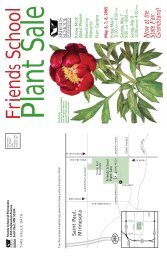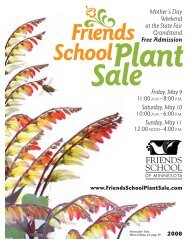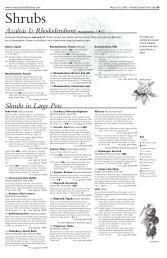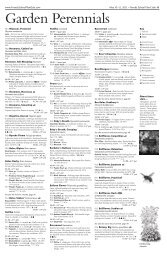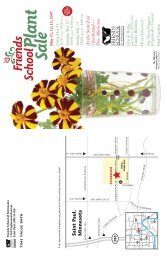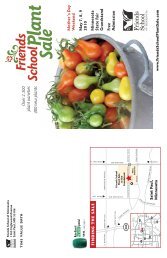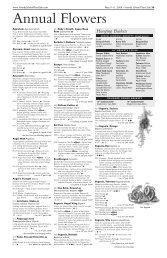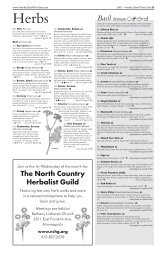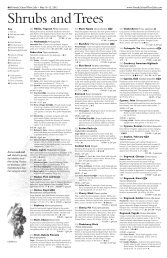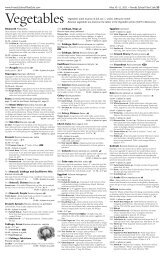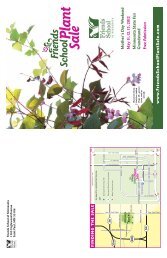View the 2013 56-page PDF here - Friends School Plant Sale
View the 2013 56-page PDF here - Friends School Plant Sale
View the 2013 56-page PDF here - Friends School Plant Sale
You also want an ePaper? Increase the reach of your titles
YUMPU automatically turns print PDFs into web optimized ePapers that Google loves.
www.<strong>Friends</strong><strong>School</strong><strong>Plant</strong><strong>Sale</strong>.com May 10–12, <strong>2013</strong> • <strong>Friends</strong> <strong>School</strong> <strong>Plant</strong> <strong>Sale</strong> 41<br />
Fruit<br />
We accept cash, checks, Amex,<br />
Visa, MasterCard & Discover<br />
Apple Malus domestica<br />
Beautiful spring flowers, white and fragrant, and fall<br />
fruit. ÍΩ˙Ç<br />
$39.00—5 gal. pot:<br />
F001 Haralson—Class of ’22 “graduate” of <strong>the</strong><br />
University of Minnesota eager for work in nor<strong>the</strong>rn<br />
climates. Distinctive tart flavor, very crisp and<br />
juicy. Semi-dwarfing rootstock. 9–30’h by<br />
10–14’w<br />
F002 Liberty ◊—Dwarf tree produces tart juicy<br />
crisp apples mid-season. 8–15’h by 8–10’w<br />
$45.00—5 gal. pot:<br />
F003 Honeycrisp—The most popular apple developed<br />
at <strong>the</strong> University of Minnesota. Great for eating<br />
fresh or storing. Ideal for <strong>the</strong> home orchard.<br />
Semi-dwarfing rootstock. ***** 15–20’h by<br />
15–20’w<br />
$55.00—5 gal. pot:<br />
F004 Dwarf Honeycrisp ◊—The most popular<br />
apple developed at <strong>the</strong> University of Minnesota.<br />
Great for eating fresh or storing. This smaller version<br />
is ideal for <strong>the</strong> home orchard. 12–15’h<br />
F005 Apple, Columnar Malus ◊<br />
Scarlet Sentinel—Compact apple trees can be grown<br />
in containers. Slim and tall, this fragrant-flowering<br />
variety bears full-sized, red apples touched with yellow.<br />
A good choice for narrower borders. 8–12’h by 2–3’w<br />
ÍΩÇ<br />
$49.00—7 gal. pot<br />
Apricot Prunus<br />
Beautiful white flowers in mid spring, followed by a<br />
heavy crop of early-ripening fruit. Best in a north- or<br />
east-facing location to prevent early blooms and frost<br />
damage. Will fruit best with two varieties. ÍΩ<br />
$20.00—1 quart pot:<br />
F006 Briana, P. armeniaca—Heavy yields for an edible<br />
landscape, originally from nor<strong>the</strong>rn Russia. Fruit<br />
is a light orange in color with a dark orange interior,<br />
1 to 1.5” in size. Dense clusters on short<br />
spurs along <strong>the</strong> branches. Rich flavor with few<br />
disease or insect problems. 15–25’h by 15–25’w<br />
Ç<br />
$55.00—5 gal. pot:<br />
F007 Goldcot ◊—Medium-sized round fruit with<br />
golden skin and firm orange flesh. Needs full sun<br />
and a pollinizer. 15–30’h by 10–20’w<br />
Blackberry, Thornless Rubus<br />
Delicious for pies, cobblers, turnovers, topping ice<br />
cream, and adding to cereal. Upright, thornless canes<br />
bear large antioxidant-rich fruit in early summer. Pale<br />
pink flowers are attractive to bees, butterflies as well<br />
as birds. Self-pollinizing Í∫ΩÇ<br />
$8.00—4” pot:<br />
F008 Chester ◊—Semi-sweet, firm blackberries.<br />
One annual crop. 3–5’h by 3–5’w<br />
$12.00—1 gal. pot:<br />
F009A Black Satin Thornless ◊—Productive and<br />
semi-erect with deep blue-black fruit in mid to<br />
late summer. Best on a trellis or planted along a<br />
fence. 3–4’h<br />
F009B Blackberry, Dwarf Red<br />
Rubus pubescens<br />
This trailing berry makes a great groundcover for any<br />
moist woodland area. The thornless stems develop<br />
decorative white flowers followed by small tart berries.<br />
It is not a heavy producer, but <strong>the</strong> berries are well<br />
worth <strong>the</strong> work to pick. Seed from St. Louis County,<br />
Minn. 6–12”h Í∏ Ω∫˝˜ $7.00—4” pot<br />
Blueberry Vaccinium<br />
Popular for <strong>the</strong>ir fruit, compact size and brilliant fall<br />
colors of orange and red. Pink flowers. Prefer acidic<br />
soil! These are self-pollinizing unless noted o<strong>the</strong>rwise,<br />
but will get larger fruit if a different variety is nearby<br />
for cross-pollination. ÍΩ∫Ç<br />
$12.00—1 gal. pot:<br />
F010 Aurora, V. corymbosum—The latest fruiting blueberry<br />
on <strong>the</strong> market. Large, sweet berries August-<br />
September. Resistant to cracking and store well.<br />
Deep red fall color. 4–5’h<br />
F011 <strong>Friends</strong>hip, V. corymbosum—Super hardy blueberry<br />
delivers great wild berry taste on vigorous, productive<br />
plants. From native plants in <strong>Friends</strong>hip,<br />
Wis. Fruits mid-July to August (early for blueberries).<br />
Brilliant orange-red fall color. 3–4’h<br />
F012 Top Hat, V. angustifolia—Attractive, dwarf variety.<br />
Great for small gardens, even pots or for bonsai.<br />
Plump, delicious berries. 2–3’h by 5–8’w ˜<br />
$14.00—1.5 gal. pot:<br />
F013 Northland—Flexible branches do not break<br />
under heavy snow loads. Fruit is borne on long<br />
and loose clusters; nice wild berry flavor. Low<br />
stature and spreading growth habit also make it<br />
an attractive landscape plant. 2–4’h by 3–4’w<br />
Blueberry continued<br />
$15.00—1 gal. pot:<br />
F014 Chippewa—A 1996 U of M introduction. A good<br />
plant for <strong>the</strong> home gardener with large dark blue<br />
fruits and good blueberry flavor. 2.5–3.5’h by<br />
2.5–3.5’w<br />
F015 Northsky—Midseason berries. Developed at <strong>the</strong><br />
U of M. 2–3’h<br />
F016 Pink Lemonade—Sweet deep pink berries in<br />
summer. 4–5’h by 3–4’w<br />
Cherry, Bush Prunus<br />
Extremely ornamental in spring when covered in beautiful<br />
flowers followed by bright red fruit. The cherries<br />
are delicious fresh or make sensational jams or pie.<br />
Can bear three or four quarts of berries per plant.<br />
Requires more than one variety for pollination. ÍÇΩ<br />
$6.00—4.5” pot:<br />
F017 Carmine Jewel—A Canadian introduction. Fruit<br />
larger than a nickel ripens early, from mid-July to<br />
mid-August. Vigorous but few suckers. 6–8’h by<br />
3’w<br />
$9.00—3.5” pot:<br />
F019 Jan, P. japonica x P. jacquemontii—White blooms.<br />
4’h<br />
F020 Joel, P. japonica x P. jacquemontii—Pink blossoms.<br />
4’h<br />
Cherry, Pie Prunus cerasus<br />
Dwarf trees with beautiful spring blossoms, followed<br />
by tart full-size cherries. Excellent summer food used<br />
by over 80 species of wildlife. Self-fertile. ÍÇΩ<br />
$39.00—5 gal. pot:<br />
F021 North Star—Very hardy and very productive U of<br />
M introduction. Great for cooking and freezing.<br />
Ripens in July. 12–14’h<br />
$49.00—5 gal. pot:<br />
F022 Montmorency ◊—Valued as <strong>the</strong> best pie<br />
cherry but one that many people like to eat.<br />
Heavy harvest in late July; one local gardener<br />
reports up to nine gallons of fruit. 15–20’h by<br />
10–20’w<br />
$55.00—5 gal. pot:<br />
F023 Balaton ◊—White flowers become a firm tart<br />
cherry with red skin and red flesh. 10–18’h<br />
Cherry, Sweet Prunus avium<br />
Less hardy than sour cherries, <strong>the</strong>se sweet cherries will<br />
do better with protection from afternoon sun in <strong>the</strong><br />
winter as well as <strong>the</strong> northwest wind. All of <strong>the</strong>se<br />
require ano<strong>the</strong>r sweet cherry variety nearby for<br />
pollination. 15–30’h by 15–30’w ÍΩ<br />
$39.00—5 gal. pot:<br />
F024 Bing ◊—Fragrant flowers with large firm<br />
heart shaped fruits with deep maroon color.<br />
Enjoyed by song birds.<br />
F025 Black Tartarian ◊—Deep-purple fruits, luscious<br />
and abundant, begin forming as <strong>the</strong> palepink<br />
flowers fade on this ancient Russian native,<br />
which prefers long, cool winters and summers<br />
that aren’t too wet. The cherries are ripe by midsummer.<br />
$55.00—5 gal. pot:<br />
F026 Stark Gold ◊—Fragrant white flowers turn<br />
into golden sweet cherries in summer.<br />
Currant Ribes<br />
White flowers followed by fruits in clusters by midsummer.<br />
The fruit is good for jellies, wines and preserves.<br />
For <strong>the</strong> most fruit production, remove any<br />
stems that are more than four years old. Self-fruitful<br />
and resistant to White Pine Blister Rust. Í∏Ω∫Ç<br />
$13.00—1 gal. pot:<br />
F027 Consort—Clustered, black fruits ripen in late<br />
summer. 4–6’h by 3–4’w<br />
F028 Red Lake—Vigorous plant that breaks dormancy<br />
early. Dark red fruits will ripen earlier with additional<br />
moisture. 4’h<br />
F029 Dogwood, Cornelian Cherry<br />
Cornus mas<br />
Late winter clusters of tiny yellow flowers before <strong>the</strong><br />
leaves appear. The fruit is dark ruby red, ripening after<br />
it falls from <strong>the</strong> tree. Acidic flavor like a mix of cranberry<br />
and sour cherry, it’s mainly used for jam and an<br />
excellent sauce. Amenable to heavy clay soil. 20–25’h<br />
by 15–20’w Í∏ ÇΩ<br />
$14.00—1 gal. pot<br />
F030 Fig, Hardy Ficus carica ◊<br />
Chicago Hardy—Self-fruiting medium-sized fig tree<br />
that’s good for potted culture. Fruits in late summer<br />
until frost. Despite its name, it can’t be considered<br />
hardy <strong>here</strong>, though it may be worth trying with heroic<br />
protection, such as a giant pile of bagged oak leaves or<br />
a box built around it. O<strong>the</strong>rwise, it can be over-wintered<br />
in a large pot in an attached garage or a fruit<br />
cellar. It can also be brought indoors as a houseplant.<br />
(Fig trees moved indoors often lose all <strong>the</strong>ir leaves, in<br />
which case cut back on watering until new leaves<br />
sprout.) 10–12’h by 9–10’w Í $16.00—1.5 gal pot<br />
Goji Berry Lycium barbarum<br />
Grow superfruit in your own backyard. With <strong>the</strong> highest<br />
antioxidant values of any fruit, gojis have been<br />
treasured in China for centuries. Good fresh, dried or<br />
frozen. Requires staking. Self-fruitful. Harvest late<br />
summer to early fall. 5–7’h Í Â<br />
$9.00—5.25” pot:<br />
F031 Big Lifeberry ◊—Tasty red berries.<br />
F032 Sweet Lifeberry ◊—Royal purple flowers.<br />
Gooseberry Ribes uva-crispa<br />
Gooseberries are half-inch to one-inch round fruits with<br />
a flavor all <strong>the</strong>ir own, often used in desserts. White<br />
blossoms in spring. Green lobed foliage turns red in fall.<br />
Attracts birds and butterflies. Self- fruitful. ÍΩ∫Ç<br />
$13.00—1 gal. pot:<br />
F033 Hinnomaki Red—Large, sweet-tart red fruit in<br />
summer. 3–5’h by 3–5’w<br />
F034 Pixwell—Pinkish fruit in summer. Virtually<br />
thornless. 5’h by 3’w<br />
Grape Vitis<br />
Grow your own grapes! Vigorous vines are great for<br />
covering fences, too. Climbs by tendrils. ÍÇ<br />
$11.00—4.5” pot:<br />
F035 Frontenac Gris—A U of M cold-hardy introduction.<br />
Blush to white, it’s very good for white<br />
wines and as a seeded table grape. 8–10’h<br />
F036 Marquette—Dark purple fruits, developed by <strong>the</strong><br />
U of M’s cold-hardy grape program. Very good for<br />
wine and juice. 20’h<br />
$13.00—1 gal. pot:<br />
F037 Bluebell—Blue-black grape, excellent table quality<br />
similar to Concord in taste but hardier. 8–10’h<br />
F038 Edelweiss—Vigorous, greenish-white grape with<br />
high sugar content. Dessert and wine grape.<br />
10–15’h<br />
F039 Swenson’s Red—Extra sweet, large grape with<br />
crisp yet tender texture. Developed at <strong>the</strong> U of M,<br />
1978. 5–6’h<br />
F041 Hazelnut, American<br />
Corylus americana<br />
A rounded shrub with half-inch edible nuts, two to<br />
four in a cluster. Useful in <strong>the</strong> shrub border and in naturalistic<br />
settings; suckers from <strong>the</strong> roots to form thickets.<br />
Excellent for wildlife. Jackson County, Minn.,<br />
source. 6–8’h Í∏ Ωıǘ $11.00—1 gal. pot<br />
F042 Huckleberry, Black<br />
Gaylussacia baccata<br />
Wisconsin—White, tubular flowers cover this shrub<br />
in spring, followed by purplish-black edible berries.<br />
Prefers acid soil. 1–3’h Í∏ Ωǘ<br />
$10.00—1 gal. pot<br />
Kiwi, Hardy Actinidia<br />
Vigorous fruiting vine, not <strong>the</strong> same as supermarket<br />
kiwi. Grows in any moist but well-drained soil; should<br />
not become dry in hot wea<strong>the</strong>r. Do not over-fertilize.<br />
Twining; needs a trellis. 긂<br />
$3.00—2.5” pot:<br />
F043 Arctic Beauty, A. kolomikta—Pollinizing (nonfruiting)<br />
plant with white and pink variegated<br />
leaves, often used as a screen or shade vine<br />
because of its dense cover. One pollinizer can<br />
cover several nearby fruiting kiwi vines. 12’h<br />
$10.00—5” pot:<br />
F044 Krupnoplodnay, A. kolomikta—Fruiting plant.<br />
Pink and white variegation after several seasons.<br />
Needs a pollinizer nearby to produce fruit. 10’h<br />
$16.00—1.5 gal pot:<br />
F045 Issai, A. arguta ◊—Climbing vine will set<br />
smooth-skinned fruit one year after planting.<br />
Does not require a pollinizer, but sets more and<br />
larger fruit with one. 25’h by 10’w<br />
Key<br />
Í Full sun<br />
∏ Part sun/part shade<br />
Ó Shade<br />
Ω Good for bees<br />
ı Bird food source<br />
∫ Butterfly-friendly<br />
˙ Hummingbird-friendly<br />
ç Attractive foliage<br />
Ç Culinary<br />
´ Edible flowers<br />
˝ Ground cover<br />
 Medicinal<br />
˜ Minnesota native<br />
‰ Rock garden<br />
† Cold-sensitive:<br />
keep above 40°F<br />
¥ Toxic to humans<br />
ß Saturday restock<br />
Apricot flowers<br />
<strong>Plant</strong>s<br />
marked<br />
with<br />
Ωare good<br />
for bees





